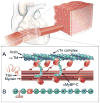Cardiac myosin binding protein-C as a central target of cardiac sarcomere signaling: a special mini review series
- PMID: 24196566
- PMCID: PMC3946865
- DOI: 10.1007/s00424-013-1396-8
Cardiac myosin binding protein-C as a central target of cardiac sarcomere signaling: a special mini review series
Abstract
Cardiac myosin binding protein-C (cMyBP-C) is a cardiac-specific thick filament assembly, accessory, and regulatory protein. Physiologically, it is a key regulator of cardiac contractility. With more than 200 mutations in the cMyBP-C gene directly linked to the development of cardiomyopathy and heart failure, cMyBP-C clearly plays a critical role in heart function. At baseline, cMyBP-C is highly phosphorylated, a condition required for normal cardiac function. However, the level of cMyBP-C phosphorylation is significantly decreased during heart failure, indicating that the level of cMyBP-C phosphorylation is directly linked to signaling and cardiac function. Early studies indicated that cMyBP-C interacts with myosin and titin, whereas studies now show that it also interacts with thin filament proteins. However, the exact role(s) of cMyBP-C in the heart remain(s) to be elucidated. As such, we invited experts in the field of cardiac muscle to identify and address key issues related to cMyBP-C by contributing a mini review on such topics as structure, function, regulation, cardiomyopathy, proteolysis, and gene therapy. Starting from this issue, Pflügers Archiv European Journal of Physiology will publish two invited mini review articles each month to discuss the most recent advances in the study of cMyBP-C.
Figures

References
-
- Bardswell SC, Cuello F, Kentish JC, Avkiran M. cMyBP-C as a promiscuous substrate: phosphorylation by non-PKA kinases and its potential significance. J Muscle Res Cell Motil. 2012;33 (1):53–60. - PubMed
-
- Bardswell SC, Cuello F, Rowland AJ, Sadayappan S, Robbins J, Gautel M, Walker JW, Kentish JC, Avkiran M. Distinct sarcomeric substrates are responsible for protein kinase D-mediated regulation of cardiac myofilament Ca2+ sensitivity and cross-bridge cycling. J Biol Chem. 2010;285 (8):5674–5682. - PMC - PubMed
-
- Bennett PM, Furst DO, Gautel M. The C-protein (myosin binding protein C) family: regulators of contraction and sarcomere formation? Rev Physiol Biochem Pharmacol. 1999;138:203–234. - PubMed
-
- Bers DM, Harris SP. Translational medicine: to the rescue of the failing heart. Nature. 473(7345):36–39. - PubMed
Publication types
MeSH terms
Substances
Grants and funding
LinkOut - more resources
Full Text Sources
Other Literature Sources
Research Materials

